Helping Hiring Managers Succeed

Introduction
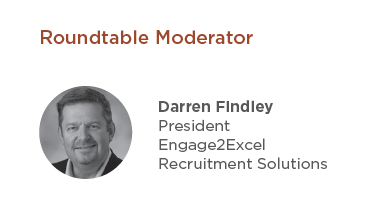 Hiring managers have a powerful influence on the success of recruitment, candidate engagement and retention strategies. In today’s job market, collaboration between HR leaders, recruiters and hiring managers is essential. However, many HR organizations struggle to find ways to effectively influence hiring managers’ skills and behaviors, which influence recruiting and retention outcomes.
Hiring managers have a powerful influence on the success of recruitment, candidate engagement and retention strategies. In today’s job market, collaboration between HR leaders, recruiters and hiring managers is essential. However, many HR organizations struggle to find ways to effectively influence hiring managers’ skills and behaviors, which influence recruiting and retention outcomes.
A troubling statistic, which has been widely reported without attribution, suggests that 57% of recruiters feel that hiring managers do not understand the recruiting process, while 63% of hiring managers feel that recruiters do not understand the jobs they are trying to fill.
This report is based on a recent roundtable discussion with talent acquisition experts on the Trendicators Advisory Board. In this session, moderated by Darren Findley, president of Engage2Excel Recruitment Solutions, we asked the participants to discuss their priorities and challenges in helping hiring managers succeed. The results of that discussion are summarized in this report.
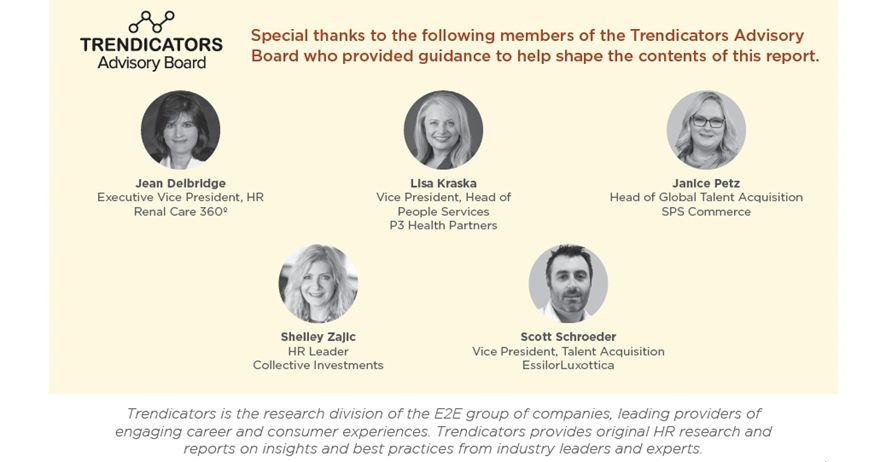
Download
 hbspt.cta.load(123973, '67776d3b-d2c1-49dd-ad6f-0573a8dc331d', {"useNewLoader":"true","region":"na1"});
hbspt.cta.load(123973, '67776d3b-d2c1-49dd-ad6f-0573a8dc331d', {"useNewLoader":"true","region":"na1"});
Streamlining Hiring Processes
Why is streamlining hiring processes important?
Streamlining hiring processes was ranked as a top priority by all our contributors as a way for HR to improve hiring managers’ rates of success. The reasons cited below for making this a priority varied based on specific organizational objectives:
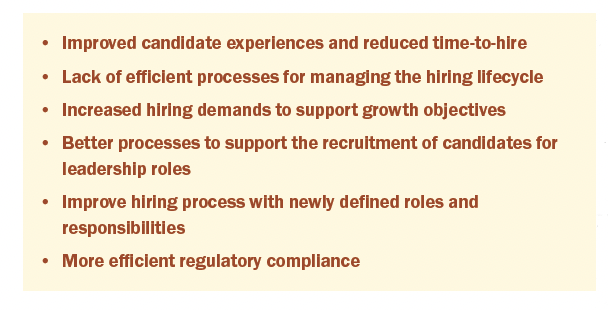

Workforce planning cited as a major bottleneck for streamlining hiring.
When asked to discuss their challenges in streamlining hiring processes, the advisors indicated that lack of effective workforce planning presents a significant bottleneck. They shared the following comments when discussing their organization’s challenges:
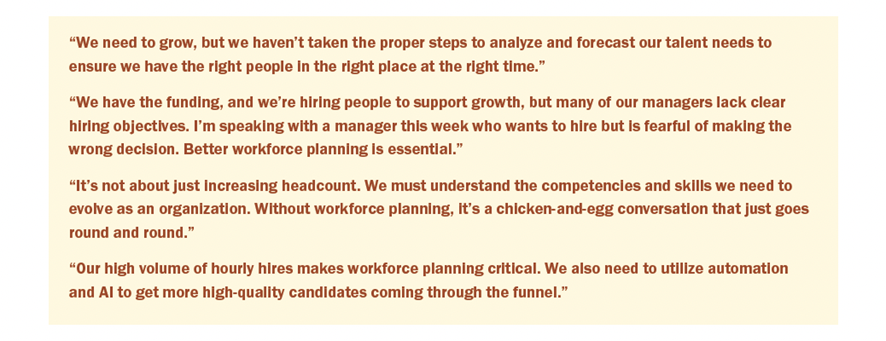
Download
 hbspt.cta.load(123973, '67776d3b-d2c1-49dd-ad6f-0573a8dc331d', {"useNewLoader":"true","region":"na1"});
hbspt.cta.load(123973, '67776d3b-d2c1-49dd-ad6f-0573a8dc331d', {"useNewLoader":"true","region":"na1"});
Providing Labor Market Context
 Labor market data provides important context for understanding regional and industry-specific employment rates, salaries and hiring trends for vacancies. Such data can help hiring managers set more realistic expectations for recruiting outcomes and include information for identifying alternative candidate pools when sourcing for hard to fill positions.
Labor market data provides important context for understanding regional and industry-specific employment rates, salaries and hiring trends for vacancies. Such data can help hiring managers set more realistic expectations for recruiting outcomes and include information for identifying alternative candidate pools when sourcing for hard to fill positions.
Advisors indicated that providing hiring managers with labor market context was a top priority for the following reasons:
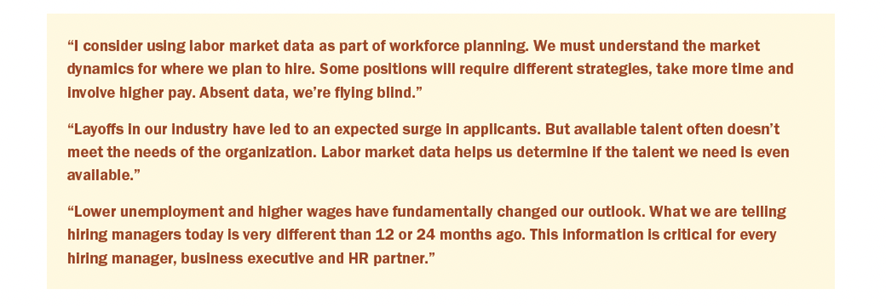
What are your challenges in utilizing labor market data?
While all advisors agreed on the need for better labor market data, accessing and isolating data for regions outside of the major metropolitan centers was mentioned as a major challenge. The cost of acquiring and analyzing this data was also discussed as a roadblock. One advisor pointed out that every organization needs to weigh the benefits of investing in internal capabilities and tools versus partnering with third-party specialists for labor market data collection and analysis.
Download
 hbspt.cta.load(123973, '67776d3b-d2c1-49dd-ad6f-0573a8dc331d', {"useNewLoader":"true","region":"na1"});
hbspt.cta.load(123973, '67776d3b-d2c1-49dd-ad6f-0573a8dc331d', {"useNewLoader":"true","region":"na1"});
Using Pre-Hire Assessments
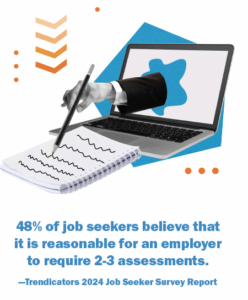 Our Trendicators 2024 Job Seeker Survey Report revealed that nearly half of all active and passive candidates said they believed it was reasonable for an employer to require 2–3 assessments. The table below provides an overview of various types of pre-hire assessments and their benefits.
Our Trendicators 2024 Job Seeker Survey Report revealed that nearly half of all active and passive candidates said they believed it was reasonable for an employer to require 2–3 assessments. The table below provides an overview of various types of pre-hire assessments and their benefits.
Two of our five advisors are currently using pre-hire assessments to streamline hiring processes. One is using a behavioral assessment to evaluate all candidates, and their leaders undergo a 12-week training course and receive coaching on the use of this tool. Another advisor indicated that they use pre-hire assessments only for leadership roles.
All advisors, however, indicated that the greater use of pre-hire assessments would benefit their organizations to improve selection, ensure better cultural fit, optimize team dynamics and and ultimately help the business run more efficiently as new hires are onboarded.
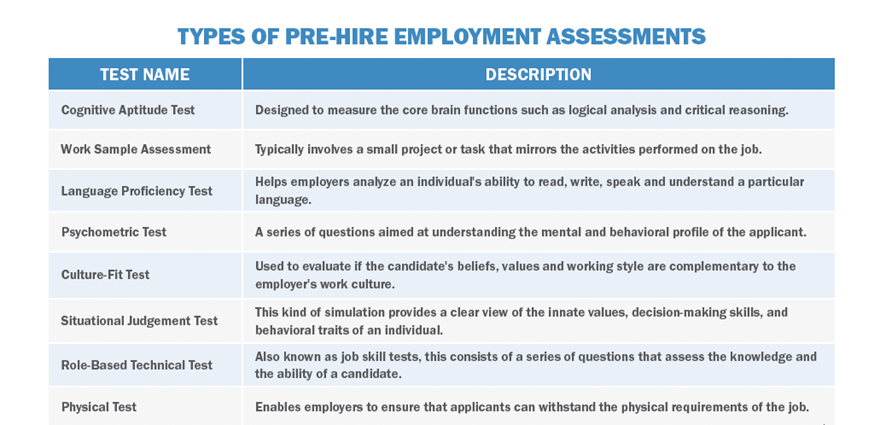 SOURCE: XOBIN
SOURCE: XOBIN
Download
 hbspt.cta.load(123973, '67776d3b-d2c1-49dd-ad6f-0573a8dc331d', {"useNewLoader":"true","region":"na1"});
hbspt.cta.load(123973, '67776d3b-d2c1-49dd-ad6f-0573a8dc331d', {"useNewLoader":"true","region":"na1"});
Optimizing The Selection Process
 When asked to discuss the ways in which their organizations could optimize processes for the selection phase of recruitment, our group indicated that sourcing and interviewing candidates had the greatest need for improvement. We also discussed opportunities for utilizing artificial intelligence (AI) tools to improve selection as well as candidate and employee experiences.
When asked to discuss the ways in which their organizations could optimize processes for the selection phase of recruitment, our group indicated that sourcing and interviewing candidates had the greatest need for improvement. We also discussed opportunities for utilizing artificial intelligence (AI) tools to improve selection as well as candidate and employee experiences.
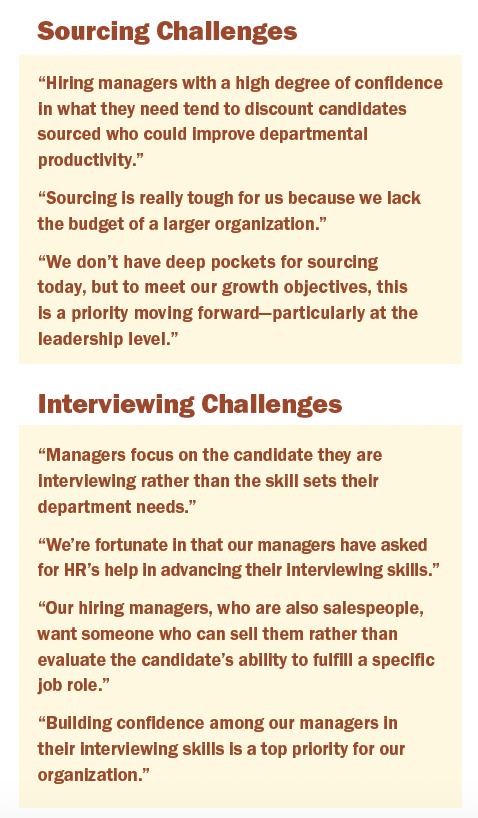
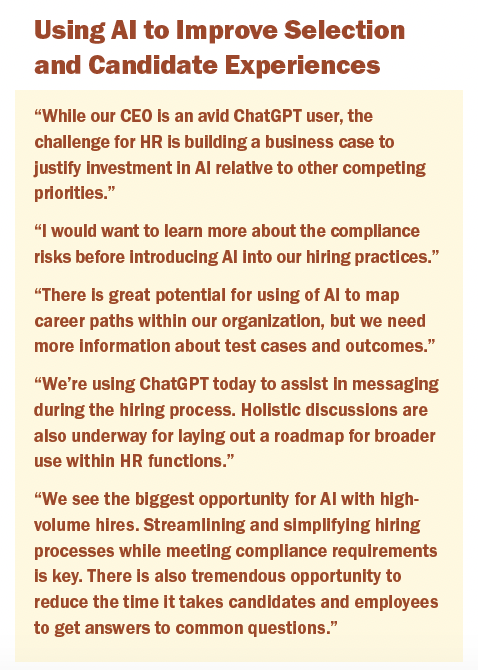
Download
 hbspt.cta.load(123973, '67776d3b-d2c1-49dd-ad6f-0573a8dc331d', {"useNewLoader":"true","region":"na1"});
hbspt.cta.load(123973, '67776d3b-d2c1-49dd-ad6f-0573a8dc331d', {"useNewLoader":"true","region":"na1"});
Boosting Early Retention
 Reducing attrition rates over the first 120 days is a challenge for all organizations. Record low unemployment, changes in work attitudes and expectations, and the high cost of replacing people who quit have made retention strategy a high priority for leaders.
Reducing attrition rates over the first 120 days is a challenge for all organizations. Record low unemployment, changes in work attitudes and expectations, and the high cost of replacing people who quit have made retention strategy a high priority for leaders.
In discussing their priorities for increasing early retention rates, our advisors focused on the need to more effectively engage new hires, improving onboarding experiences and training managers to be more effective at post-hire engagement.
Below are representative comments from this discussion along with results from our 2024 Job Seeker Survey Report, which demonstrate the importance of pre- and post-hire engagement.
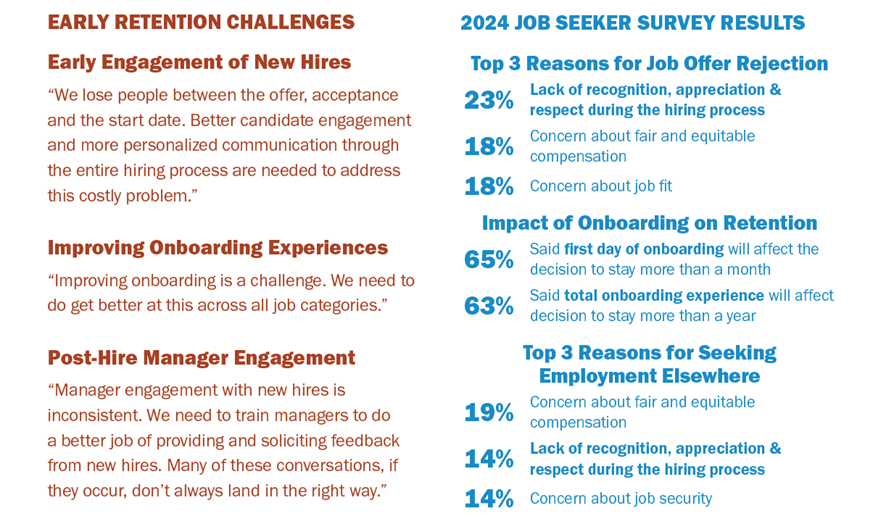
Download
 hbspt.cta.load(123973, '67776d3b-d2c1-49dd-ad6f-0573a8dc331d', {"useNewLoader":"true","region":"na1"});
hbspt.cta.load(123973, '67776d3b-d2c1-49dd-ad6f-0573a8dc331d', {"useNewLoader":"true","region":"na1"});
Tips for Building Stronger Relationships
With rare exceptions, hiring managers are not hiring experts. As discussed in this report, they often have unrealistic expectations and tend to focus on what they think they need instead of what may be best for their departments. And managers are often too busy or lack the relationship skills needed to improve the experiences of candidates and new hires. While some of these challenges can be addressed with training, hiring process improvements and other measures, recruiters can directly influence hiring success by building stronger relationships with the hiring managers and candidates they serve. Here are four recommendations to share with recruiters to help them improve their hiring success:
Get hiring managers involved early: One of the most difficult jobs of any recruiter is managing expectations. While great recruiters excel at managing the expectations of qualified candidates, many overlook the need to manage expectations with the one person who has the greatest influence on hiring success. Understanding the perceived needs and preconceptions of a hiring manager is an important first step in building a better relationship.
Help managers reimagine the ideal candidate: Create a job description that helps the hiring manager think differently about the skill levels, competencies, experience and achievements of the person who can help them achieve their goals. If possible, get input from others within the department to build different pictures of what a successful candidate might look like. This exercise can help you create a more compelling job description, improve team dynamics and expand the definition of hiring success.
Use data to help hiring managers make smarter decisions: Early insight into what may be unrealistic and uniformed expectations will help you gather the data you need to educate hiring managers about labor market realities, including salary levels, available talent pools and competition for a given role. Also, most hiring managers don’t realize the influence they have on creating positive experiences for candidates before, during and after the process of extending an offer. Let hiring managers know that a nationwide survey of active and passive candidates revealed that the top reason candidates gave for accepting or rejecting a job offer was whether they were recognized, appreciated and respected during the hiring process. Ask hiring managers if they feel they need help in improving their interviewing and candidate engagement skills.
Follow up throughout the hiring lifecycle: Collect feedback from highly qualified candidates and the hiring manager to address any concerns from either party. And while you may not consider employee retention to be part of a recruiter’s job, it is a critical indicator of recruitment success. Investing in periodic follow-ups with new hires and their managers over the first 120 days builds deeper relationships and engenders trust and credibility. Adding this process to your next job placement will make it easier for the hiring manager and position HR as a trusted resource.
Download
 hbspt.cta.load(123973, '67776d3b-d2c1-49dd-ad6f-0573a8dc331d', {"useNewLoader":"true","region":"na1"});
hbspt.cta.load(123973, '67776d3b-d2c1-49dd-ad6f-0573a8dc331d', {"useNewLoader":"true","region":"na1"});